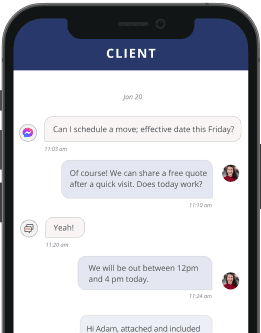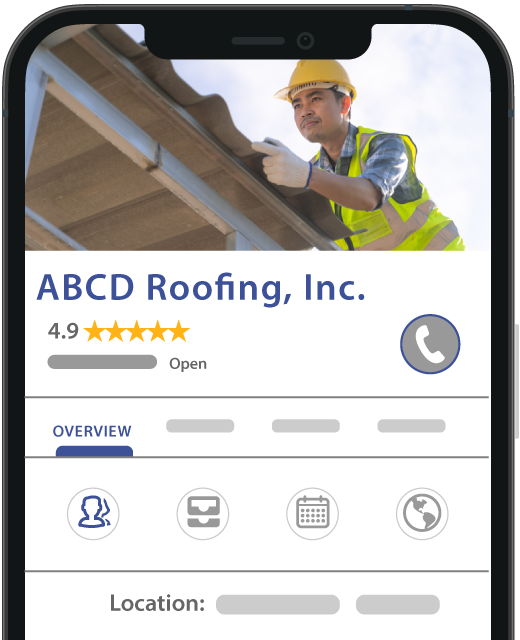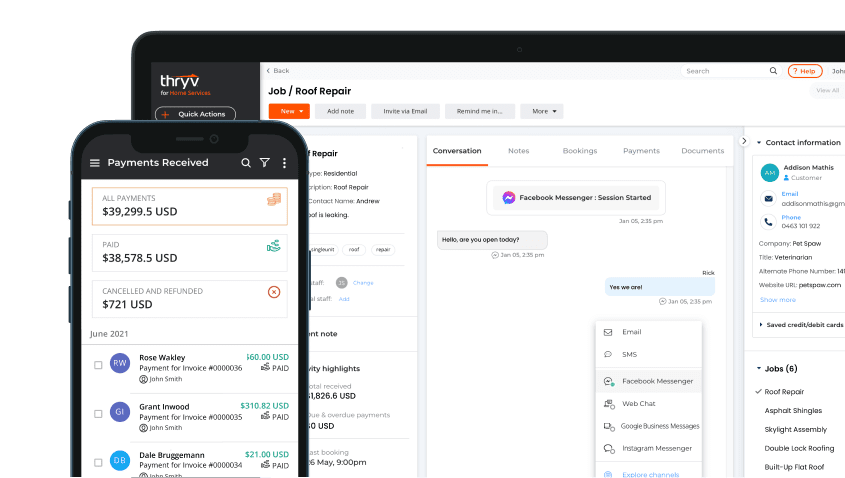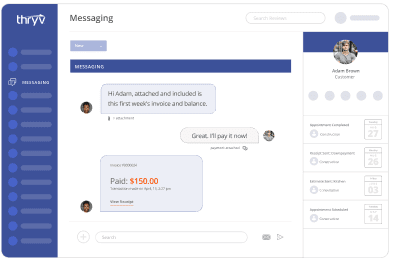The Ultimate Guide to Starting an HVAC Business in 2025
Thinking about starting your own HVAC business in 2025? You’re not alone – and you’re not too late. Heating, ventilation, and air conditioning (HVAC) services are always in demand, and right now, the industry is growing fast. With new tech, rising energy costs, and changing weather patterns, more people than ever need help staying comfortable at home and at work.
Starting a business does take work, but it doesn’t have to be complicated. With the right plan and the right tools, you can make it easier on yourself. This guide on how to start an HVAC business will walk you through each step, from setting up your business to landing your first customers, and show you how HVAC software can keep things running smoothly along the way.
Laying the groundwork: business planning essentials
Every successful HVAC business starts with a solid plan. Before you buy tools or print business cards, take time to figure out what kind of business you want to run and how you’re going to make it work. A little planning now can save you a lot of stress later.
Pick your path
HVAC businesses come in all shapes and sizes. Some focus on home systems, others work with commercial buildings, and some specialize in things like duct cleaning, heat pumps, or emergency repairs. You can stick to one area or offer a mix – just make sure you choose something that fits your skills, your interests, and the demand in your area.
Check out your local market
Do a little research. How many HVAC companies are already in your town or city? What do they charge? What services are missing? This kind of intel helps you figure out where you can stand out and how to price your work competitively.
Know your numbers
Starting an HVAC business isn’t free, but it doesn’t have to break the bank either. You’ll need money for things like tools, a vehicle, licenses, and insurance. Make a list of what you’ll need and what it might cost. Then figure out how many jobs you’ll need each month to cover your expenses and make a profit.
Write a simple business plan
You don’t need a giant 50-page document, but you do need a clear plan. Write down your goals, the services you’ll offer, how you’ll find customers, and what makes your business different. It’s also a good idea to sketch out a basic budget and timeline for getting started.
Find the right financing
If you don’t have all the cash upfront, that’s okay. Many HVAC business owners start with a loan, a line of credit, or equipment financing. Look into small business loans from banks, credit unions, or online lenders. Some even specialize in startups like yours. A strong business plan will make it easier to qualify.
Once you’ve got your plan in place, you’ll be ready to move forward with confidence – and with fewer surprises.
Covering your legal bases
Before you can start booking jobs and getting paid, there are a few more important boxes to check. Getting your business set up the right way from the start will help you avoid problems down the road and make you look more professional to customers.
Register your business
First things first: register your business with your state. You’ll also need to decide on a business structure. Many small HVAC businesses go with an LLC (limited liability company) because it protects their personal assets and keeps paperwork pretty simple. A sole proprietorship is another option if you’re working alone and want to keep things extra lean. If you’re not sure what’s best, a quick chat with a small business advisor or tax pro can help.
Get licensed
HVAC work is highly regulated, and most states (plus some cities and counties) require you to get a contractor’s license before you can operate. The rules vary depending on where you live, so check with your state licensing board. You may need to show proof of experience, pass an exam, or provide references.
Earn your certifications
If you’re working with refrigerants (and chances are, you will be), you’ll need EPA Section 608 certification. There are different levels depending on the type of equipment you work on. Other helpful certifications include NATE (North American Technician Excellence) or HVAC Excellence – these aren’t always required, but they do build trust with customers and help you stand out.
Secure the right insurance
At a minimum, you’ll need general liability insurance to protect your business if something goes wrong on a job. If you have employees, workers’ comp coverage is usually required. You may also need commercial auto insurance for your work vehicle. Talk to an insurance agent who works with small trades businesses – they’ll help you cover your bases.
Don’t forget bonding and permits
In some areas, you’ll need to be bonded to pull permits or work on certain projects. A surety bond shows that you’re financially reliable and can meet the terms of your contracts. Your local licensing office can tell you what’s required in your area.
Getting all of this sorted might feel like a lot, but once it’s done, you’ll have a legit business you can feel proud of – and that customers will take seriously.
Building your brand
Once you’ve got the paperwork out of the way, it’s time to shape your business into something customers will remember and trust. That means creating a strong brand, deciding exactly what services you’ll offer, and determining how much you’ll charge for them.
Pick a name
Your business name should be easy to say, easy to spell, and easy to remember. Try to choose something that gives customers a clue about what you do, like “Smith Comfort Solutions” or “24/7 Cool & Heat.” Once you have a name, create a logo and choose colors that feel professional and friendly. These will show up on your website, vehicle, uniforms, and other places, so make them count.
Choose your services
HVAC businesses don’t all offer the same things. You might focus on:
- Repairs and emergency calls
- New system installations
- Preventive maintenance and tune-ups
- Indoor air quality upgrades
- Smart thermostat setup
- Commercial systems
Start with what you know best and build from there. You don’t have to do it all – offering a few key services and doing them really well is often a better strategy than trying to offer everything at once.
Set your prices
Pricing can be tricky, especially when you’re new. Do some local research to see what other HVAC businesses charge for similar services. Make sure your rates cover your costs and your time, and help you earn a profit. Don’t just try to be the cheapest – customers are often willing to pay more for someone reliable, professional, and easy to work with. HVAC calculator software can help you find the right prices to charge for your work.
Buying tools, equipment, and vehicles
You can’t do HVAC work without the right gear. But that doesn’t mean you have to buy everything all at once or spend a fortune to get started. Focus on the tools and equipment you’ll use every day and build from there as your business grows.
Start with the must-haves
There are some tools every HVAC tech needs, whether you’re working solo or building a team. These include:
- A reliable set of gauges and meters
- Cordless drills and hand tools
- Leak detectors and vacuum pumps
- Safety gear like gloves, goggles, and masks
- Ladders, extension cords, and drop lights
As your services expand, you may also need things like duct cutters, nitrogen regulators, or recovery machines. Keep a running checklist and upgrade over time.
Choose your work vehicle
Your vehicle is more than just transportation – it’s a mobile workshop and a rolling billboard. Many HVAC pros go with a van or pickup truck that has room for tools, parts, and safety gear. If you can, get shelving or storage bins installed to keep things organized and cut down your time at job sites. Later on, you can wrap your vehicle with your business name and logo to advertise while you drive.
Buy or lease in smart ways
Brand-new tools and vehicles are nice, but they’re not always necessary at the start. You can often find high-quality used equipment through trusted suppliers, HVAC forums, or trade groups. Leasing is also an option if you want to save cash up front or avoid big purchases while your business is still finding its footing.
Marketing your HVAC business in 2025
You can be the best HVAC tech in town, but if people don’t know you exist, you won’t get far. Marketing doesn’t have to be fancy or expensive. It just needs to help the right customers find you, trust you, and remember you when they need help.
Build a website that brings in leads
Your website is your digital storefront. Even if you’re just starting out, it should look clean, load fast, and make it easy for people to contact you. Include your services, service area, a few customer reviews, and a clear way to request an estimate or book a job. Adding photos of your work or team can help build trust.
Use local SEO to show up in search
Most people search for HVAC services online, usually starting with Google. To show up in those searches, make sure your business is listed on Google Business Profile and that your name, address, and phone number are consistent across the web. Encourage happy customers to leave reviews – it really helps with visibility and HVAC lead generation.
Leverage Google Local Services Ads
These ads appear at the very top of search results and are designed for service businesses like yours. They’re pay-per-lead, which means you only pay when someone contacts you through the ad.
Stay connected with email and text
Once you’ve got a few customers, stay in touch! Send reminders for seasonal maintenance, offer special discounts, or share helpful tips. Software for HVAC companies makes it easy to send emails or texts to your whole customer list without having to do it manually.
Get social – on your terms
You don’t have to be on every platform. Choose one or two (like Facebook or Instagram) and post simple updates: before-and-after pics, behind-the-scenes videos, or quick tips for homeowners. It shows you’re active, helpful, and real.
Don’t forget old-school marketing
Yard signs, flyers, and partnerships with local realtors or property managers can also help spread the word. A personal recommendation still goes a long way.
Run smart promotions
Offer discounts for first-time customers, referral rewards, or seasonal tune-up specials. A limited-time offer can be a great way to get your phone ringing, especially when you’re just starting out.
The goal is to get noticed, earn trust, and stay top-of-mind. With the right mix of online and offline HVAC marketing ideas – and the right tools to help – you’ll build a steady stream of leads in no time.
Managing operations and customer relationships
Running a successful HVAC business isn’t just about doing great work – it’s also about staying organized and giving your customers a smooth, professional experience. The right systems and tools can save you time, reduce mistakes, and help you keep customers coming back.
Stay on top of scheduling and dispatching
As jobs start coming in, you’ll need a clear way to manage appointments. Good scheduling software lets you assign jobs, see your calendar at a glance, and avoid double-booking. Some tools even let customers book online, which makes things easier for everyone.
Make invoicing and payments simple
No one likes chasing down payments. With the right HVAC business software, you can send invoices as soon as a job is done and give customers easy ways to pay by credit card, bank transfer, or even mobile. You’ll get paid faster, and your cash flow will become more predictable.
Use a CRM to track your customers
A CRM (customer relationship management) tool helps you keep all your customer info in one place – names, addresses, service history, and notes from past jobs. That way, when someone calls again, you’ll have everything you need to pick up right where you left off. It also helps you follow up with reminders, seasonal offers, or check-ins.
Automate the small stuff
Things like appointment confirmations, review requests, and reminder texts can all be automated. That means fewer missed appointments, better communication, and less time spent on admin. Automated software for HVAC businesses is designed to handle all of this, so you don’t have to.
Track your money
Even if you’re not a numbers person, you need to know what’s coming in, what’s going out, and where you’re making money. Use accounting software (or hire a bookkeeper) to stay on top of your finances, handle taxes, and plan for growth.
Connect it all in one place
Running a business is a lot easier when your systems talk to each other. A unified platform lets you manage scheduling, payments, marketing, and customer info all in one spot – no jumping between apps or losing track of things.
When your operations run smoothly behind the scenes, you can focus on what you do best: helping customers and growing your business.
How Thryv can help
Starting and running an HVAC business comes with a lot of moving parts – from scheduling jobs to staying on top of payments, customer communication, and marketing. That’s where Thryv® comes in.
Thryv is a do-it-all business management platform built for small service businesses like yours. Thryv’s HVAC management software helps you keep everything organized, streamlined, and professional, so you can spend less time on paperwork and more time doing the work you actually enjoy.
With Thryv, you can:
Whether you’re just getting started or you’re ready to scale, Thryv’s HVAC software for small businesses gives you the tools to run a professional operation from day one.
Why Thryv?
Here’s what makes Thryv a smart choice:
- One login, one dashboard. No more switching between dozens of different apps. Everything you need to run your business is right there, in one simple platform.
- Access it anywhere. Because Thryv is cloud-based, you can log in from your phone, tablet, or laptop – whether you’re in the field, at the office, or at home.
- Your data stays safe. Thryv uses advanced data encryption and customizable account access controls to protect your business and customer information.
- It works with the tools you already use. Thryv integrates with popular apps like QuickBooks®, Gmail®, and more, so you don’t have to give up the tools you already rely on.
- Support when you need it. Have a question? Need help setting something up? Thryv’s support team is available 24/7 to back you up.
Additional resources
- HVAC Inspection Checklist: How to Pass HVAC Inspection
- Free Tools for HVAC Business Management
- Small Business Software for HVAC Businesses



